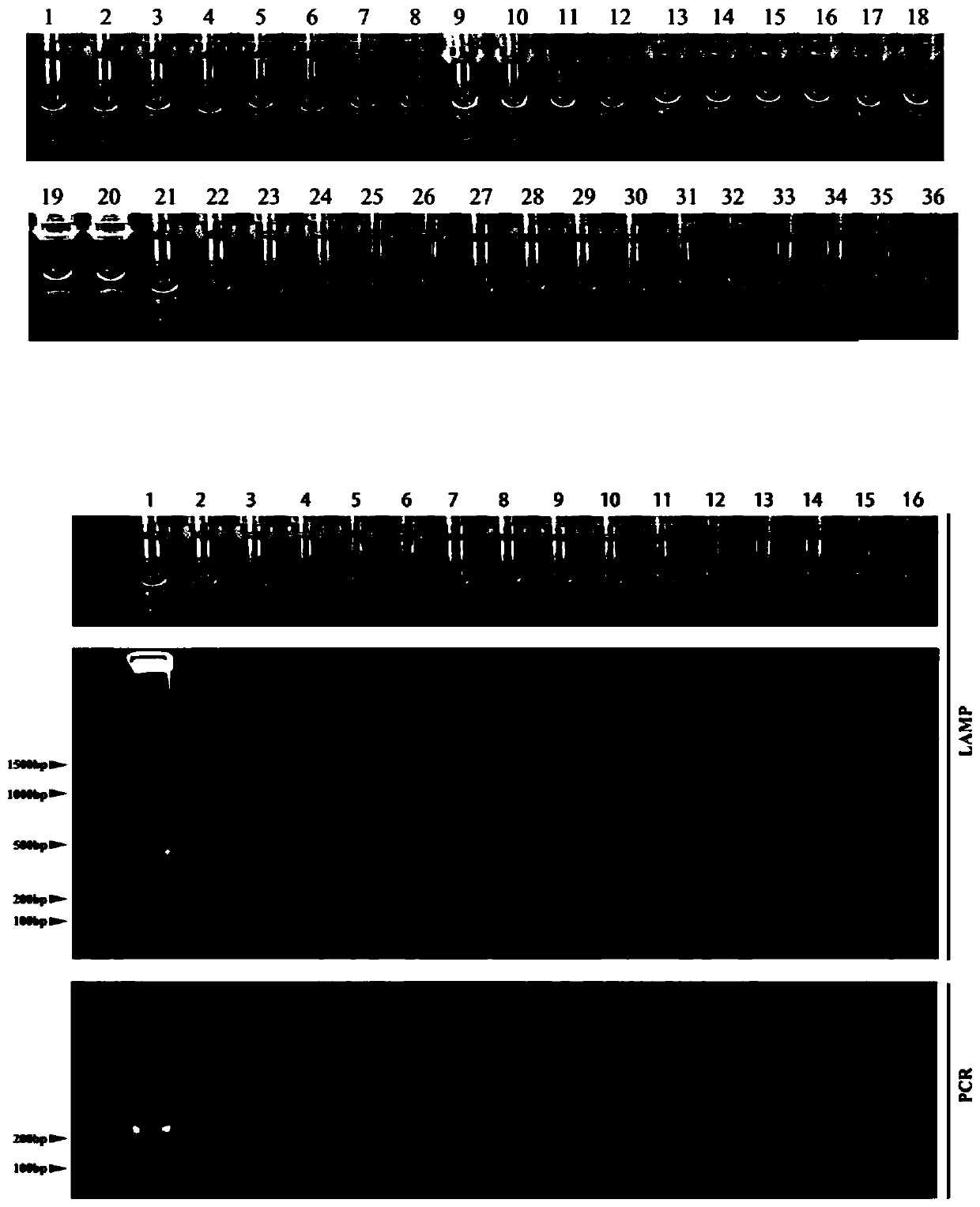The application of the specific sequence of Rapeseed blackleg subspecies in the detection of Rapeseed blackleg
A technology of black shank bacteria and rapeseed, which is applied in the field of application of specific sequences in the detection of rapeseed black shank bacteria, can solve the problems of difficulty in satisfying real-time and rapid detection in the field, high requirements for equipment staff, and long detection cycle of detection methods, etc., to achieve The effect of fast and simple stability, good specificity and high sensitivity
- Summary
- Abstract
- Description
- Claims
- Application Information
AI Technical Summary
Problems solved by technology
Method used
Image
Examples
Embodiment 1
[0028]Application of the sequence shown in SEQ ID NO.1 or the primers designed for the sequence in the detection of rapeseed blackleg bacteria (L.biglobosa 'brassicae'):
[0029] For the sequence shown in SEQ ID NO.1, LAMP primers were designed as follows:
[0030] F3:5'-GTATTGGCCGCGAATTCC-3'
[0031] B3:5'-GGAGATTGGCCACTATGG-3'
[0032] FIP: 5'-GGCGTCTCTTTTATGGCTATTTTCTGGTCAAAAAGTTGGTTTGGA-3'
[0033] BIP: 5'-AATGTCAGGAAGTCTGAAAAGCTCACGTTCTCTGATCAGGAC-3'
[0034] LF:5'-CCGAAATGAATTGTACCAGTATCCT-3'
[0035] LB: 5'-ACTGCCTCATGCAACATGG-3'.
[0036] The LAMP amplification system is as follows:
[0037]
[0038] Bst 2.0 WarmStart DNA Polymerase was purchased from New England Biolabs.
[0039] The LAMP amplification procedure is as follows:
[0040] React at 65°C for 40 minutes; inactivate at 80°C for 5 minutes
[0041] Add 1000×SYBR Green I to the reaction product, the positive reaction shows fluorescent green, indicating the presence of L.biglobosa 'brassicae' in rapes...
Embodiment 2
[0043] Specific detection and sensitivity detection of LAMP primers for L.biglobosa ‘brassicae’:
[0044] Specific detection of LAMP primers for L.biglobosa 'brassicae':
[0045] A total of 35 bacterial strain samples were selected, and the primers provided by the invention were specifically detected:
[0046] 21 strains of L.biglobosa 'brassicae' collected from winter rapeseed producing areas in China; 2 strains of subspecies L.biglobosa 'c anadensis'; 2 strains of closely related species L.maculans; 10 strains of pathogenic fungi isolated from rapeseed ( In order: Phoma sp., Phoma macrostoma, Phoma sp., Phoma glomerata, Phoma herbarum, Botrytis cinerea, Sclerotinia sclerotiorum, Colletotrichum sp., Alternaria alternata, Chaetomium globosum), all strains are shown in Table 1.
[0047] Using the method described in Example 1, the strains described in Table 1 were tested for LAMP. In Table 1, "+" indicates a positive result, and "-" indicates a negative result.
[0048] Tabl...
Embodiment 3
[0054] Example 3: Field Application of LAMP-specific Detection Primers for Rapeseed Blackleg Germ
[0055] Rapeseed stalks with diseases were collected in rapeseed producing areas (Chibi, Hubei, Xianning, Inner Mongolia, Fansan, Inner Mongolia, Minle, Gansu, Xining Huzhu, Inner Mongolia, Wuduhe, Hanzhong, Shaanxi, Huaihua, Hunan, Ningbo, Zhejiang, Guiyang, Guizhou, etc.) and selected randomly. The stalks of 7 rapeseed black shanks with obvious symptoms and 6 rapeseeds without symptoms were extracted from the diseased tissues, and the LAMP primers provided by the present invention were used for LAMP detection. The results showed that the 7 rapeseeds with diseased The presence of Lbb of rapeseed blackleg was detected, and the existence of rapeseed blackleg Lbb was also detected in 2 rapeseeds of 6 asymptomatic rapeseed plants, and only 4 plants did not detect the existence of the pathogen ( image 3 ), cultured the stalks of 2 rapeseed plants with no symptoms and tested positive...
PUM
 Login to View More
Login to View More Abstract
Description
Claims
Application Information
 Login to View More
Login to View More - R&D Engineer
- R&D Manager
- IP Professional
- Industry Leading Data Capabilities
- Powerful AI technology
- Patent DNA Extraction
Browse by: Latest US Patents, China's latest patents, Technical Efficacy Thesaurus, Application Domain, Technology Topic, Popular Technical Reports.
© 2024 PatSnap. All rights reserved.Legal|Privacy policy|Modern Slavery Act Transparency Statement|Sitemap|About US| Contact US: help@patsnap.com










